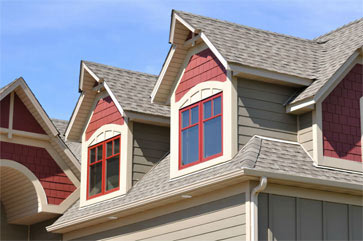We Hope You Enjoy Reading Our On-site Blogs

From Underlayment to Eaves: Get to Know the Different Parts of Your Roof

As a homeowner, you might not pay much attention to your roof until something goes wrong. Then you may start to realize how little you know about the structure that stabilizes your home and protects your family from the elements.
Get to know more about your roof's basic parts so you'll be prepared to discuss your roof issues with a professional roofer.
Underlayment
The underlayment is a protective material located underneath your roof's shingles or tiles. The underlayment stops air and moisture from damaging your ceiling and roofing materials. There are several options for underlayment, including fiberglass and asphalt.
If a storm is powerful enough, it can not only damage the roof's outer materials but also tear at the roof's underlayment. If this happens, you'll need to get the damage repaired right away so the underlayment can continue to protect your roof and home.
Flashing
Flashing is a waterproof material that directs water downward, preventing water from collecting in various areas of your roof. This function is crucial because water buildup can cause your roof to decay. Flashing is installed around various parts of your roof, including:
- Roof valleys (where your roof planes meet)
- Vents
- Skylights
- Chimneys
- Pipes
- Eaves (the roof's edges)
Different flashing materials include aluminum, PVC, galvanized steel, and copper.
High-quality flashing that's been installed well can last a long time. Still, if you're getting your roof repaired or replaced, it's best to have the roofers take a close look at the flashing as well.
Fascia and Soffit
The fascia is located under the roof's edge and supports both the roof and the gutters. The soffit fits under the fascia.
The soffit and fascia shield both the roof and the home from water damage. They may also have ventilation to prevent condensation in your roof and attic.
Although they protect your home from water, your fascia and soffit are still susceptible to water damage. Animals can also chew through and damage the material. If you notice rotting, holes, or cracks in your soffit and fascia, you'll need to get these roofing parts repaired.
Gutters and Downspouts
When it rains, the water flows through the gutters and falls out through the downspouts. This way, the water doesn't damage your home's foundation and walls.
Problems with your gutters and downspouts can lead to extensive water damage to your roof and home. If you notice any cracks or leaks in your gutters or downspouts, get them fixed right away. You also want to make sure your downspouts face the correct angle so water falls well away from your home's foundation.
Clogs are common with gutters. When leaves and debris build up in your gutters, water can no longer exit your roof. Get your gutters cleaned at least twice a year to prevent this problem.
Eaves
The eaves are the roof's edges that protrude over the side of your home. Like the gutters and downspouts, the eaves help direct water away from your house. This function prevents water damage and decay to your home.
Like other parts of your roof, your eaves are susceptible to damage from weather and animals. For example, if your gutters clog, water can seep into the eaves and cause them to rot. If you notice water damage or holes in your eaves, call a roofing professional.
Each of these roofing parts is an essential part of your overall roofing structure. A minor problem with one of these parts could lead to more serious problems with other areas of your roof.
If you notice an issue with any of these roofing parts, call a roofing company right away. Call MW Roofing LLC for superior roofing services.



